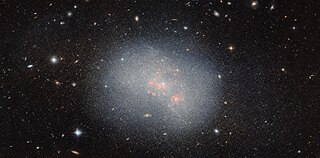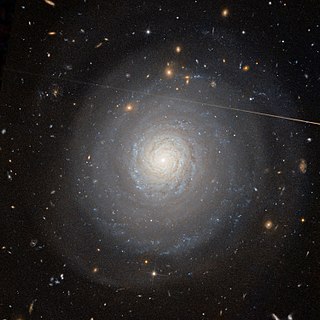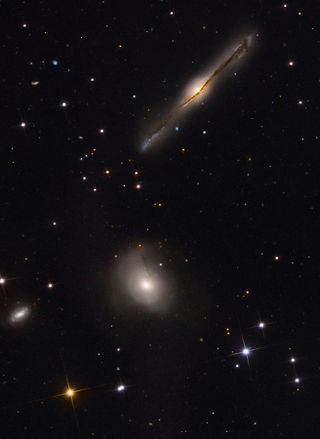
NGC 4309 is a lenticular galaxy located about 55 million light-years away in the constellation Virgo. The galaxy was discovered by astronomer Christian Peters in 1881 and is a member of the Virgo Cluster.

NGC 4323 is a lenticular or dwarf elliptical galaxy located about 52.5 million light-years away in the constellation Coma Berenices. The galaxy was discovered in 1882 by astronomer Wilhelm Tempel and is a member of the Virgo Cluster.

NGC 5238 is an irregular galaxy in the constellation Canes Venatici. Located at a comoving distance of 4.51 Mpc, it is 64.4 arcseconds in diameter. It has sometimes been classified as a blue compact dwarf galaxy. Although some authors have hypothesized it to be a member of the M101 Group of galaxies, it is currently believed to be an isolated galaxy.

NGC 4274 is a barred spiral galaxy located in the constellation Coma Berenices. It is located at a distance of circa 45 million light years from Earth, which, given its apparent dimensions, means that NGC 4274 is about 95,000 light years across. It was discovered by William Herschel in 1785.

NGC 4699 is an intermediate spiral galaxy located in the constellation Virgo. It is located at a distance of about 65 million light years from Earth, which, given its apparent dimensions, means that NGC 4699 is about 85,000 light years across. It was discovered by William Herschel in 1786. It is a member of the NGC 4699 Group of galaxies, which is a member of the Virgo II Groups, a series of galaxies and galaxy clusters strung out from the southern edge of the Virgo Supercluster.

MCG +07-33-027 is an isolated spiral galaxy located about 330 million light-years away in the constellation Hercules. It has a very high rate of star formation which would make it a starburst galaxy. Normally, starburst galaxies are triggered by the collision of another galaxy. However most galaxies are in groups or clusters, while MCG +07-33-027 is solitary. Therefore, the cause of the starburst was not due to a collision or by the passing of a nearby galaxy and so the cause of the activity remains unknown.

NGC 3675 is a spiral galaxy located in the constellation Ursa Major. It is located at a distance of circa 50 million light years from Earth, which, given its apparent dimensions, means that NGC 3675 is about 100,000 light years across. It was discovered by William Herschel in 1788.

NGC 4340 is a double-barred lenticular galaxy located about 55 million light-years away in the constellation of Coma Berenices. NGC 4340 was discovered by astronomer William Herschel on March 21, 1784. NGC 4340 is a member of the Virgo Cluster. NGC 4340 is generally thought to be in a pair with the galaxy NGC 4350.

NGC 3726 is a barred spiral galaxy located in the constellation Ursa Major. It is located at a distance of circa 45 million light years from Earth, which, given its apparent dimensions, means that NGC 3726 is about 85,000 light years across. It was discovered by William Herschel on February 5, 1788.

NGC 7606 is a spiral galaxy located in the constellation Aquarius. It is located at a distance of circa 100 million light years from Earth, which, given its apparent dimensions, means that NGC 7606 is about 165,000 light years across. It was discovered by William Herschel on September 28, 1785. The galaxy is included in the Herschel 400 Catalogue. It lies 45 arcminutes northeast from psi2 Aquarii. It can be seen with a 4 inch telescope but its visibility is greatly affected by light pollution.

NGC 7723 is a barred spiral galaxy located in the constellation Aquarius. It is located at a distance of circa 90 million light years from Earth, which, given its apparent dimensions, means that NGC 7723 is about 95,000 light years across. It was discovered by William Herschel on November 27, 1785. The galaxy is included in the Herschel 400 Catalogue. It lies 1.5 degrees north-northwest from Omega1 Aquarii. It can be seen with a 4-inch telescope under dark skies.

NGC 7184 is a barred spiral galaxy located in the constellation Aquarius. It is located at a distance of circa 100 million light years from Earth, which, given its apparent dimensions, means that NGC 7184 is about 175,000 light years across. It was discovered by William Herschel on October 28, 1783.

NGC 3489 is a lenticular galaxy located in the constellation Leo. It is located at a distance of about 30 million light years from Earth, which, given its apparent dimensions, means that NGC 3489 is about 30,000 light years across. It was discovered by William Herschel on April 8, 1784. NGC 3489 is a member of the Leo Group.

NGC 1386 is a spiral galaxy located in the constellation Eridanus. It is located at a distance of circa 53 million light years from Earth, which, given its apparent dimensions, means that NGC 1386 is about 50,000 light years across. It is a Seyfert galaxy, the only one in Fornax Cluster.

NGC 680 is an elliptical galaxy located in the constellation Aries. It is located at a distance of circa 120 million light years from Earth, which, given its apparent dimensions, means that NGC 680 is about 100,000 light years across. It was discovered by William Herschel on September 15, 1784.

NGC 4312 is an edge-on unbarred spiral galaxy located about 55 million light-years away in the constellation Coma Berenices. It was discovered by astronomer William Herschel on January 14, 1787. NGC 4312 is a member of the Virgo Cluster and is a LINER galaxy.

NGC 3435 is a barred spiral galaxy located about 235 million light-years from the Milky Way, and is about 125 000 light-years across. It can be found in the constellation Ursa Major. It was discovered on 9 April 1793 by astronomer William Herschel.

NGC 864 is a star-forming barred spiral galaxy located in the Cetus constellation. It's also classified as an isolated galaxy on the AMIGA catalogue as CIG 96. Its discovery and first description was realized by William Herschel in October 25th, 1785 and the findings made public through his Catalogue of Nebulae and Clusters of Stars, published in 1786.

NGC 2935 is a large intermediate spiral galaxy located in the constellation Hydra. Its speed relative to the cosmic microwave background is 2,601 ± 23 km/s, which corresponds to a Hubble distance of 38.4 ± 2.7 Mpc. NGC 2935 was discovered by German-British astronomer William Herschel in 1786.

NGC 4328 is a nucleated dwarf elliptical or lenticular galaxy located about 48 million light-years away based on observations by the Hubble Space Telescope using the TRGB distance indicator. NGC 4328 was discovered on March 21, 1784 by astronomer William Herschel and is a member of the Virgo Cluster in the "A'' subgroup. On the sky, NGC 4328 is located in the constellation Coma Berenices.























